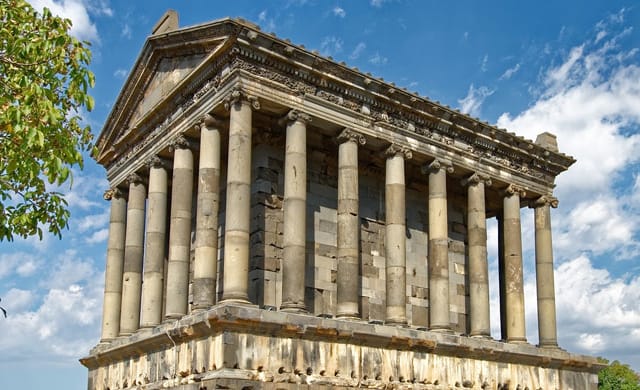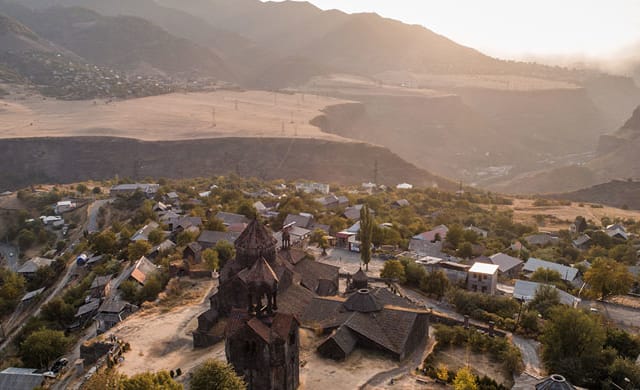Armenia, a country of a thousand hidden treasures
4.9/5195 reviews
Discover Armenia, a unique cultural and natural gem.
Let yourself be enchanted by the history and beauty of Armenia.
Must-see locations
Armenia: between breathtaking landscapes and millennial traditions
For a long time a pilgrimage land for Armenians of the diaspora, the country has been opening up to all visitors for several years. Its main attractions are its high mountains, lakes, and valleys, which house countless churches and monasteries, reminding us that Armenia was the first Christian state. A land of memory, Armenia is also an adventure land prized for hiking. To grasp its many facets, there is nothing like a trip organized by a local agency! Indeed, Armenians are undoubtedly the best placed to authentically showcase this country that is still making its debut in tourism.
A Hidden Treasure to Explore
Taking a trip to Armenia means discovering an unknown country, far from mass tourism. Born on the ruins of the Russian Empire, present-day Armenia occupies only the eastern part of historic Armenia and is home to barely half of the Armenians worldwide. This country, rich in history and culture, offers diverse landscapes ranging from majestic mountains to lush valleys. Visitors can explore ancient monasteries, savor delicious local cuisine, and meet warm and welcoming locals. Armenia is an ideal destination for those seeking an authentic and enriching experience.

Must-see Places to Visit
Visiting Armenia means first discovering its beautiful capital, Yerevan. Its historic center is rich in beautiful 19th-century buildings, charming small squares, and museums, while its outskirts are marked by Soviet-era edifices. The cultural life in Yerevan is vibrant, with numerous concerts, theaters, and art galleries. But what makes the Armenian capital so endearing is above all the warm welcome and kindness of its inhabitants.
Located at 1,900 meters altitude and covering a total area of 940 km², Lake Sevan is a refreshing stop in summer, while there is scorching heat in Yerevan. This makes it almost as famous as Mount Ararat! With its deep blue color, it is also one of Armenia's richest lakes in fish, perfect for fishing enthusiasts.
About 10 km from Garni and its superb Greco-Roman temple, not far from Yerevan, in the middle of a canyon, lies the Geghard Monastery. This monastery, named after the spear that pierced Christ's body, was built in the 13th century. It is particularly notable for being largely underground. It is a must-see on any trip to Armenia.

Discover Authentic Armenia: Hidden Treasures and Unique Landscapes
Cross the suspension bridge to the Goris caves
Near the village of Goris, there is an impressive suspension bridge over the void in a gorge of the Caucasus Mountains. Crossing it is always an exhilarating experience. However, it is advised that people prone to vertigo refrain.
Take the Tatev cable car
Not far from Goris is a monastery perched on an 850-meter cliff. To get there, you can take a cable car from the village of Halidzor. It's a memorable experience as this cable car is one of the longest in the world.
The magnificent Jermuk waterfall
Perched at over 2,000 meters above sea level, Jermuk is a spa town in the high mountains of Armenia. It is famous for its healing springs but also for its magnificent waterfall, 70 meters high, which flows into the Arpa River.
Discovering Armenia
Armenia is not a conventional tourist destination, which has its advantages for travelers who enjoy going off the beaten path. This unique character results in specific tourist infrastructures, typical of many countries from the former USSR. However, one gains in authenticity and sometimes in exoticism and picturesque charm. The sense of disorientation is further ensured by Armenia being a country at the crossroads of cultures, where the East meets the West. Armenian Christianity, with its liturgy inherited from Byzantium and rites influenced by paganism, is decidedly Eastern. Yet, the contrast is striking between a Romanesque monastery nestled in a prairie landscape and the sun-scorched high plateau reminiscent of the steppes of Central Asia. In Yerevan, the appeal of the West is visible among the youth, who are sensitive to musical and fashion trends coming from the West. However, the Eastern nonchalance of people on café terraces reminds one of the proximity to Iran.
A website by
Customize your trips with Quotatrip and receive tailor-made offers directly in your inbox.
Discover a country